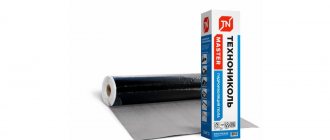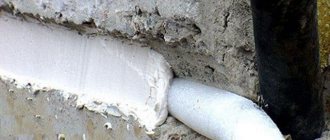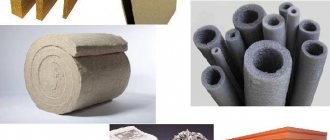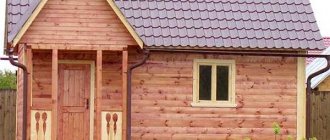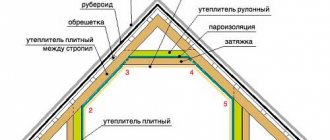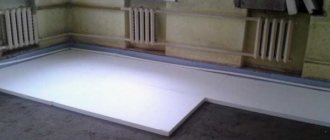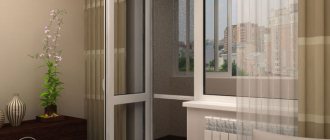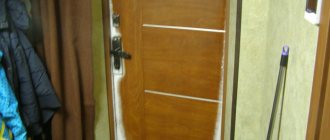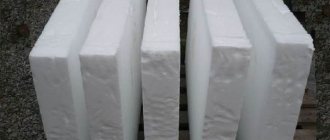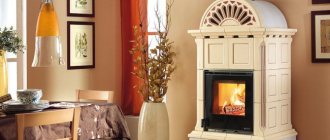Waterproofing walls is a mandatory procedure when constructing a building. Unprotected surfaces will be exposed to moisture - precipitation, condensation - and deteriorate, and mold may appear on them. When carrying out work, it is necessary to strictly adhere to the technology; this is the only way to ensure protection of brick, wooden or concrete surfaces from water, extending the service life of the house.
Application of liquid waterproofing
Sources of moisture
Condensation forms on the internal surfaces of the walls in the room. This occurs due to increased air humidity. In bathrooms, kitchens, basements, non-residential buildings (garage, shed, workshop), especially if they do not have a heating system, air humidity is constantly increased, so protecting the walls from the inside is mandatory.
Another reason for the appearance of condensation is insufficient quality insulation of the house.
External surfaces come into contact with precipitation and groundwater.
Why is waterproofing needed?
The absence of a waterproof coating will significantly reduce the service life of the building; the material (concrete, brick, wood) will deteriorate, cracks, mold, and moss will appear on it. To prevent this from happening, you need to waterproof the walls outside and inside.
In addition, protecting internal surfaces will help:
- prevent the appearance of damp smell;
- maintain an optimal indoor microclimate;
- protect pipes and other metal structures from corrosion;
- delay the need for cosmetic and major repairs.
Pasted waterproofing
An adhesive-type waterproofing coating is a continuous waterproof carpet made of roll, film or sheet rot-resistant materials. It is used for waterproofing the underground part of building walls, applied to a concrete or brick surface.
Types of adhesive waterproofing:
- Ruberoid, hydrostekloizol, other bitumen-based materials
- Materials based on a synthetic polymer base - film made of polyethylene, polypropylene, polyisobutylene, PVC
The coating option is selected depending on the hydrostatic head. The number of layers is affected by the hydrostatic head and relative humidity in the room.
Technologically, the process of installing adhesive waterproofing includes the stages of rolling, gluing and rolling the sheets. The waterproofing carpet is glued layer by layer on the outer surface of the structure on the side exposed to water. Priming is carried out first. It is impossible to glue canvases from different layers mutually perpendicular.
The bubbles that appear during installation of the carpet are pierced, then the air is released until the adhesive composition appears from the puncture. If there is no composition under the bubble, the canvas is cut crosswise, the cut edges are folded back, coated with an adhesive along with the base and glued again.
Particular attention is paid to the weak point of the adhesive waterproofing – the joints of the panels. The canvases are glued with a shift relative to each other so that the seams are spaced apart.
If the height of the surface to be waterproofed does not exceed 3 m, bitumen-based roll materials are glued immediately along the entire height from bottom to top. At a greater height, the canvas is glued in pieces 1.5–2 m long from bottom to top with an overlap along the length. Polymer films are cut into pieces of the required length and welded into enlarged sheets on workbenches.
As adhesives, mastics or glues are used, the viscosity of which is sufficient to prevent the canvas from sliding off the vertical surface until the mastic sets. For bitumen-based roll materials, hot or cold bitumen mastic is used; for polymer materials, synthetic glue is used.
The adhesive waterproofing should not be subjected to constant shear or tensile loads. The coating is protected from mechanical damage by pressing it with a protective structure.
Types of waterproofing materials
According to their purpose, materials are divided into 4 types:
- sealing;
- anti-corrosion;
- hydro- and heat-insulating;
- antifiltration.
In appearance, waterproofing can be liquid or roll.
An example of using rolled waterproofing
Bitumen mastic
Bitumen is an elastic mass that is a product of oil refining. Creates a dense waterproof film on the surface and is not subject to cracking. Fills the smallest cracks, penetrates into the pores of the base. Used in combination with roll material or independently. Designed to protect the wall from the outside and treat the foundation.
Bitumen mastic is easy to apply; even a person with no experience can cope with the task. The work takes a little time. The material is sold in the form of bars, which must be heated to 150 degrees to melt before use.
The disadvantages include the duration of hardening. If low-quality compounds are used, the resulting coating may crack over time.
Polymer mastic
Polymer mastics are acrylic-based plastic adhesive compositions used for waterproofing walls from the inside or outside. In addition to protection from moisture, it improves the thermal insulation properties of the treated surface.
Advantages of polymer mastic:
- forms a dense, even coating that does not require finishing;
- fireproof;
- protects against moisture, fungus, moss;
- has a safe composition that allows its use in bathrooms and other rooms;
- Available in a wide range of colors;
- resistant to sub-zero temperatures;
- dries quickly;
- elastic, when the base dries or deforms, it retains its integrity.
Colored polymer mastic
Deep penetration compositions
Dry mixtures containing quartz sand, cement and polyurethane resins are diluted with water immediately before use. After drying, they form an airtight film that reliably protects the surface.
The application technology is extremely simple; the work can be performed by a non-specialist. Penetrating compounds are used primarily inside the home.
Roofing felt and roofing felt
Both materials are used to waterproof the outside of the wall and protect the foundation from moisture.
Ruberoid is a rolled material consisting of a base (cardboard, fiberglass) and impregnation (most often bitumen). Roofing felt is a cardboard sheet impregnated with a tar composition. The first is superior to the second in its properties; only it costs less.
Membrane (film)
It is a roll material made of synthetic rubber or PVC. Used indoors and outdoors. A significant drawback is instability to mechanical stress. Waterproofing film for walls can easily be damaged during installation.
Covering the foundation wall with a membrane
Injection waterproofing
This type includes:
- epoxy compounds;
- acrylate gels;
- polyurethane compounds.
Holes are drilled in the wall in increments of 50 cm into which liquid is injected under high pressure. The method is quite expensive and requires special equipment, so its use is justified only in very complex cases when it is impossible to use other materials.
Protecting walls from moisture and water - waterproofing mixtures, ready-made waterproofing and other means
Protecting walls from moisture is an important condition for quality construction or renovation. This allows you to avoid many unpleasant consequences in the future and make the building more durable.
The walls of the house are constantly exposed to moisture, which seeps into building structures from the soil, interior spaces, as a result of rainfall and melting snow. Therefore, external walls must be carefully insulated from such exposure.
Dangerous effects of water on building materials
Moisture can destroy concrete, brick, and metal structures. Even if it is not contaminated with chemicals, it dissolves the components inside building materials. But most often, water contains impurities that have entered it as a result of industrial emissions from exhaust gases. Its acidity increases so much that it dissolves the salts in the brick and, after evaporation, forms characteristic efflorescence on its surface.
For wooden structures, it is not only dampness itself that poses a danger, but also microorganisms that multiply intensively in damp places. Mold and fungi lead to the rotting of logs, boards, beams, as a result, wooden structures lose strength, and the atmosphere in the house becomes hazardous to health.
Due to the freezing of water inside building materials, their destruction occurs, since the resulting ice breaks their structure. Frequent cycles of freezing and thawing cause even the most durable brick to crumble and become unsuitable for construction.
Saving a house from water - waterproofing mixtures and ready-made waterproofing
Waterproofing technologies help prevent all of these problems. They are quite diverse, and their differences lie in both the principle of action and the use of certain drugs and materials. A suitable waterproofing method is chosen taking into account the characteristics of the wall material and the reasons for the ingress of moisture (precipitation, steam from living quarters). Since the foundation is exposed to groundwater, the waterproofing method in this case will be different.
The walls of the house must first of all be protected from moisture that seeps into them through the foundation. When erecting walls, roofing felt or roofing felt is laid on the foundation, creating a durable and airtight layer.
The façade needs reliable protection from rainwater and atmospheric humidity. At the same time, waterproofing should not spoil the appearance. One option is to apply plaster and paint with special compounds that form a waterproof film. In addition, polymer cement solutions, drying plaster compositions, molten bitumen mastic, and all kinds of film products are used. An advanced method is the use of penetrating waterproofing, when the concrete surface is treated with a compound that clogs the capillaries.
There are numerous water repellents that create very reliable protection from moisture and at the same time do not interfere with the attractiveness of external walls. This technology involves the use of impregnations with water-repellent properties for the treatment of concrete and wooden surfaces. Any building material that has a porous structure can be treated with a similar composition. It penetrates several centimeters deep and prevents further absorption. But at the same time, the treated surface retains the ability to “breathe”. Hydrophobization is used to protect against short-term exposure to sputum (rain, dew), but this method will not help with prolonged contact.
Vapor barrier membranes
Humidity in the form of steam poses a great threat to insulation, as it leads to a decrease in insulation capabilities. To prevent the insulation from getting wet, vapor barrier membranes made of perforated polyethylene and polypropylene are used. Some polyethylene products are covered with heat-reflecting foil on one side.
The strength of polypropylene films is very high, so they are preferable to polyethylene films. Since condensation can form on the surface of the film, polyethylene is covered with a viscose fiber layer, which absorbs moisture and dries quickly. Additional protection of the insulation from getting wet is provided by the air gap between it and the film.
The use of so-called “breathing” membranes helps protect thermal insulation from absorbing moisture from the atmosphere. But the peculiarity of the membranes is that they do not prevent water vapor from escaping. This is due to the presence of synthetic fibers in the membrane and the specifics of its microstructure. Such films are also called windproof films. In addition, windproof boards with thermal insulation characteristics are used. Their advantages include good strength, tightness of joints, and durability (about 60 years).
Location of insulation cover
Waterproofing a wall can be done in 2 ways: horizontal and vertical.
Vertical
This method is used both during the construction process and during renovation work. Use roll or liquid waterproofing material or both at the same time.
Horizontal
The rolled material is laid on the base where the wall is being built. Roofing material or film will prevent the absorption of moisture from the cellar, basement or soil.
Horizontal waterproofing
Installation of horizontal waterproofing is possible only at the construction stage.
Protecting walls with special plaster
In historical premises, the walls are made of brick and often have high humidity. To effectively remove this moisture, sanitizing plaster is used. This is a special plaster composition with a large-porous structure that effectively sucks moisture out of the wall and actively evaporates it without visible traces. Apply indoors in a layer of 2 cm.
This type of plasters can be painted in any color, but it is necessary to use vapor-permeable paint for mineral substrates.
Selection of materials
- The coating composition is sold in all construction stores; each manufacturer offers its products upon purchase, which should be ensured that there are documents confirming the quality and origin of the material.
- To treat wooden surfaces, use a waterproofing compound with additives that prevent the development of fungi and mold. Surface treatment should be carried out immediately after completion of construction. If mold appears on the wall, disinfect the area, clean it and treat it with an antiseptic as soon as possible.
- Before gluing the rolled material, a brick or concrete wall is treated with a primer to increase adhesion.
- When choosing any material, it is better to give preference to well-known brands, even if the price is slightly higher than analogues.
Waterproofing walls helps to increase the life of the building; in this matter, you should not skimp on the choice of protective coating. It is better to carry out high-quality waterproofing once than to spend additional funds annually on repairs and eliminating the consequences of water penetration into the premises.
Internal protection
Waterproofing of internal walls is carried out using polymer mastics or fixing the membrane.
Procedure for applying mastic:
- The prepared and cleaned surface is leveled with cement plaster.
- Apply primer.
- After drying, the surfaces are covered with a layer of waterproofing. In total, several layers will be required.
Polymer films are used for walls in an apartment or private house. Membrane installation:
- The sheathing is attached to the insulated surface.
- Insulation is placed in the cells between the racks.
- Using slats, the film is attached to the frame. Place it vertically, the stripes overlap.
- The cladding is carried out with finishing material.
If necessary, you can attach 2 layers of film - directly to the wall, before installing the sheathing, then to the frame itself.
Features of waterproofing foundations and basement walls
The main feature of the foundation waterproofing process is that the surfaces requiring treatment are buried in the soil, and they will need to be cleared by digging a trench around the perimeter of the building.
Before starting work, you need to inspect the foundation and eliminate all defects.
Waterproofing of basement walls from the inside is carried out using bitumen mastic, roofing felt, and membrane.
Waterproofing a basement wall
Foundation waterproofing
The foundation of the building must be as strong and durable as possible. Only high-quality building materials are used for its construction. However, this part of the structure is exposed to intense moisture in one or another state of aggregation. Moisture can damage the integrity of the foundation structure in a relatively short period of time, making the entire building unsafe for occupancy.
To protect the foundation, water-repellent components are added to the material from which it is built. A blind area is built around it to drain water. Rolled insulators are placed under the base of the foundation.
Foundation waterproofing must be carried out
Waterproofing of external walls
To protect external surfaces, you can use bitumen, roofing felt, or a combination of both.
Coating technology
Procedure:
- Cleaned surfaces are primed with a special composition (you can use bitumen diluted with gasoline). Apply the liquid with a brush. Wait until it dries. Apply a second layer.
- Cover with bitumen mastic preheated to a liquid state. If the composition is too thick and difficult to spread, add a small amount of solvent or gasoline to obtain the desired consistency. Particular attention is paid to the joints of the material from which the foundation is made.
- After applying the first layer, wait until it hardens. Cover with another one.
In order for waterproofing to perform its intended function, its total thickness must be at least 3 mm.
Pasting principle
Waterproofing the external walls of a house with rolled material is carried out as follows:
- The cleared surfaces are primed in 2 layers.
- Heat a strip of roofing felt or roofing felt using a hair dryer or burner. The impregnation needs to soften.
- Apply the material to the bottom edge of the surface horizontally (parallel to the ground).
- Press with force and carefully iron so that the roofing felt sticks tightly to the outer wall and there is no air left inside.
- The next strip is fixed vertically, with its lower end touching a horizontally fixed section of roofing material. The remaining strips are fixed in the same way, making an overlap of about 20 cm.
- The joints must be additionally sealed. Bitumen mastic is suitable for this.
Combined method
Waterproofing an external wall with roofing felt
For high-quality and reliable waterproofing of the walls of a house, you can use a liquid composition and rolled material.
In this case, first the surface is coated with bitumen mastic, and roofing material is laid on it.
The simplicity of the technology and the absence of the need to use special equipment make it possible to carry out work on protecting walls from moisture with your own hands, and the tangible benefits - a significant increase in the service life of the building - justify the investment of time and money.
Autonomous waterproofing of walls
For independent work, it is better to choose a combination of materials, such as bitumen mastic and any other rolled material impregnated with bitumen. It is in this combination that they will allow you to properly build a waterproofing system and ensure the durability of the protective and finishing layer of the room.
Waterproofing walls from the inside and outside is carried out in the following ways:
- Horizontal waterproofing is a method in which, after cutting the walls in a horizontal plane, the space is filled with waterproof material. In some cases, an injection method is used in which the capillaries are blocked and the walls become hydrophobic.
- Vertical waterproofing is not as effective because, while preventing moisture from penetrating into the building, it cannot completely protect the walls from increased moisture at height, creating a favorable environment for the appearance of fungus. This method is used more effectively in difficult cases.
Although any structures require waterproofing, this issue remains most relevant when it comes to a brick house. Brick is an affordable and popular building material, which is characterized by a porous structure that absorbs water and destroys walls. This applies to both private and multi-storey buildings.
